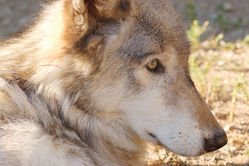
Lakota, a 15 1/2-year old wolf at the International Wolf Center, was euthanized last Nov. 7. A consultation with the Center’s veterinarian, Dr. Chip Hanson, led to the assessment that Lakota’s metabolic system was declining; she had stopped eating and was unable to deal with ambient conditions. While anti-inflammatory medication provided some relief, her condition continued to decline. Wolves in the wild may live eight to 10 years; captive wolves sometimes live as long as 14 to 16 years.
“We have an ethical responsibility to all of our captive wolves, especially to those at the end of their lifespan. Staff diligently monitors physical and behavioral signs to determine if an animal is under stress or suffering in any way, and we implement management decisions in the most humane ways possible,” said wolf curator Lori Schmidt.
Lakota, a great plains subspecies of the gray wolf (Canis lupus nubilus) was born on April 24, 1993, at Bear Country, USA, near Rapid City, South Dakota. She was noted for her role as the omega or lowest ranking pack member. She maintained this pack status throughout her entire life and was often the instigator of dominance chases. Lakota dispersed into retirement in 2002, along with her littermates, Mackenzie and Lucas and continued to maintain the lowest rank of the pack, still the instigator of chases, although a bit slower as she aged.
Lakota outlived her littermates. Lucas died of cancer in July 2006, and MacKenzie died of a pulmonary embolism in May 2008. During her last six months of life she had a unique management situation as a lone pack member.
Wolf Care staff developed new management strategies to ensure that Lakota’s physical and behavioral needs were met.
Access to the wolf lab was the most significant management situation. She became acclimated to the indoor kennel, which later proved important for veterinary care. She became quite fond of taking items from the lab and running back into the Retired enclosure. Her list of larceny items included: pillows, backpacks, water bottles, bags of dog toys, sweatshirts, pizzas, block of cheese, a compass, stuffed moose and a bag of grass seed, just to name a few. Her role as the instigator of chases did not diminish as the sole pack member; now it was the Wolf Care staff chasing her.
Donations are accepted into the Wolf Care Fund in her name and are used for current and future wolf care needs. They may be given in-person, mailed to 1696 Highway 169, Ely, MN 55731 or entered online at www.wolf.org.





